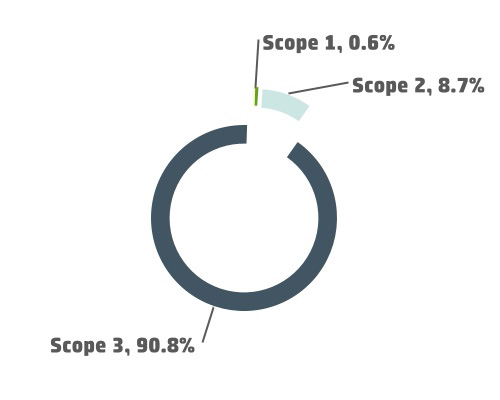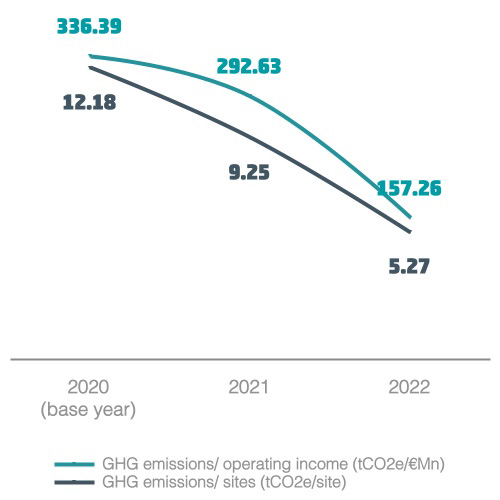The Greenhouse Gas (GHG) emissions inventory is a key instrument for understanding the global dimension of the impact of the Company's activity on climate change, as well as the development of GHG emissions over time and Cellnex's value chain. As such, this year Cellnex has once again calculated and certified, through an independent external body, Scope 1, 2 and 3 of the Carbon Footprint following the ISO 14064-1:2018 standard, as well as the criteria of the GHG Protocol, for all countries and at corporate level. Additionally, internal audits related to the carbon footprint have been conducted since 2021. In 2022 audits were performed in eight countries (France, Poland, the Netherlands, Denmark, Sweden, Finland, Switzerland and Corporate).
Since 2021, in addition to the ISO 14064-1:2018 standard, emissions are reported and verified according to the classification established by the Corporate Accounting and Reporting Standard of the Greenhouse Gas Protocol (GHG Protocol), developed by the World Business Council for Sustainable Development. In the case of Scope 3 emissions, the classification established in the GHG Protocol publication “Corporate Value Chain Accounting and Reporting Standard (Scope 3)” is used.
According to the verification, the verified emissions inventory for 2022 is 558,011 tCO2e using the market-based approach (recalculated at 931,409 and 1,065,310 tCO2e in 2021 and 2020, respectively).
The decrease in emissions is due mainly to implementation of the actions defined in the Energy Transition Plan regarding the purchase of renewable electricity.
In line with the GHG protocol with the market-based approach, 90.8% of the emissions correspond to Scope 3, followed by Scope 2 with 8.7% and Scope 1 with under 0.6% of GHG emissions.
|
Carbon emissions according to GHG Protocol (t CO2e) |
|||
|
Category |
2022 |
2021 |
2020 |
|
Scope 1: direct emissions |
3,212 |
3,623 |
3,940 |
|
Scope 2: indirect emissions |
48,329 |
326,857 |
432,160 |
|
Scope 3: other indirect emissions |
506,470 |
600,929 |
629,210 |
|
3.1. Goods and services purchased |
32,724 |
31,963 |
37,138 |
|
3.2. Capital goods |
40,807 |
43,755 |
43,819 |
|
3.3 Fuel and energy-related activities |
57,079 |
102,419 |
88,937 |
|
3.4. Transport and distribution upstream |
132 |
14,256 |
16,140 |
|
3.5. Waste generated in operations |
33 |
4,750 |
4,798 |
|
3.6. Business trips |
1,147 |
45,318 |
56,785 |
|
3.7. Displacement of employees |
2,553 |
2,159 |
1,553 |
|
3. 8. Leased assets upstream |
107,265 |
109,271 |
114,808 |
|
3.13. Leased assets downstream |
264,729 |
310,719 |
342,177 |
|
Total |
558,011 |
931,409 |
1,065,310 |


Emission intensities have reduced over recent years mainly due to the efforts made in green electricity consumption (scope 2). With regard to this strategy, it is worth highlighting the difference between scope 2 market-based emissions (48,329 tCO2e) and local-based emissions (340,262 tCO2e) as a indication of Cellnex's commitment to reduce its carbon impact.
The GHG emissions disclosed for 2021 and 2020 (as base year) have been recalculated and restated, due to changes in the perimeter, Further information can be found in Chapter 7.3. Carbon footprint: Scope and calculation methodology.
Since 2015, as part of its efforts to mitigate GHG emissions, Cellnex has offset emissions to achieve neutrality in scope 1 for all the countries. In 2022 Cellnex offset 3,212 tCO2e by acquiring 3,212 CER (certified emission reductions) credits in two different projects:
The projects are:
|
Total GHG emissions
558,011 tCO2e in 2022 |
-48% reduction vs base year 2020 |
|
|
|

In line with the recommendations in the TCFD "Metrics and Objectives" pillar, Cellnex recognises the importance of measuring the total emissions that its activity generates as this enables the Company to draw a roadmap for setting emission reduction targets, which will allow the company to achieve climate neutrality.
In this regard, in 2019 Cellnex committed to developing a science-based emissions reduction target, in line with the Science-Based Targets Initiative (SBTi), which aims to increase companies' commitment to sustainable management and seek more ambitious solutions to climate change. This initiative, aligned with the Paris Agreement, aims to help establish science-based climate change strategies to reduce greenhouse gas emissions. As such it aims to limit global warming to well below 2°C above pre-industrial levels and to continue efforts to limit warming to 1.5°C.
In 2021 Cellnex established three specific objectives for the reduction of emissions which have been validated by the Science-Based Targets initiative (SBTi) and are aligned with the Global Pact "Business Ambition for 1.5ºC". These reduction targets are the first essential step in defining Cellnex's Net-zero Strategy.
In 2022 Cellnex has been working on the roadmap to achieve these objectives, such as defining the 2023-2025 Climate Change Strategy. Specific actions were also undertaken with suppliers, in addition to energy management actions.
| Cellnex's achievements in 2022 | ||
| 77% sourcing of renewable electricity | 79% reduction in scope 1 and 2 GHG emissions and scope 3 GHG emissions from fuel and energy-related activities | 9% reduction in absolute scope 3 GHG emissions from purchased goods and services and capital goods |
| Cellnex's Science-Based Targets commitments (SBTs) | ||
|
Increasing the annual supply of renewable electricity from 0% in 2020 to 100% by 2025 |
Reducing absolute Scope 1, 2 GHG emissions and Scope 3 GHG emissions (fuels and energy) 70% by 2030,compared to base year 2020. |
Reducing absolute Scope 3 emissions (goods and services and capital goods) by 21% by 2025,compared to base year 2020. |
"Combating global warming is one of our greatest challenges and the solution is to reach net-zero by 2050. It is a long and complex process that will require research, technological advances and investment. I am proud that Cellnex has made this global commitment, which demonstrates a strong will to move towards a more sustainable business model".
Yolanda Romero, EHS-Q project manager - Cellnex CorporateThe most significant challenge in today's world is the climate crisis. As the latest IPPC (Intergovernmental Panel on Climate Change) report states “global warming, reaching 1.5°C in the near-term, would cause unavoidable increases in multiple climate hazards and present multiple risks to ecosystems and humans. Near-term actions that limit global warming to close to 1.5°C would substantially reduce projected losses and damages related to climate change in human systems and ecosystems, compared to higher warming levels, but cannot eliminate them all”. Recognising this serious situation, Cellnex is actively working to limit the effects of climate change and contribute to the decarbonisation of the economy.
According to the Science-based Targets initiative (SBTi), net-zero carbon emissions are achieved when anthropogenic greenhouse gas (GHG) emissions to the atmosphere are balanced by anthropogenic removals over a period of time. For cities and businesses, this means balancing the emissions produced by the organisation's operations and supply chain with the emissions removed from the atmosphere.
Cellnex's 2019-2023 Strategic Sustainability Plan has been updated in the 2023-2025 Environment and Climate Change Strategy. Cellnex wants to go one step further, giving substance to its commitment to the decarbonisation of the economy by defining a strategy to reduce and neutralise its emissions with specific objectives in the medium and long term: the Cellnex Net-zero Strategy. This strategy is a key component of the 2023-2025 Environment and Climate Change Strategy, as well as the Company's ESG Master Plan, and will allow Cellnex to be a net-zero company by 2050, with the intermediate goal of being Carbon Neutral by 2035.
Under the Net-zero Strategy, the Company will develop a roadmap with specific medium and long term goals to accelerate the transition towards a net-zero business model. The first lines of action that were established set out three types of measures:
To this end, Cellnex has established a strategy to reduce GHG emissions as far as possible and neutralise residual emissions that cannot be reduced. The strategy is structured around the following seven pillars:
With the implementation of the planned GHG emission reduction measures, there are a number of residual emissions that are not within Cellnex's control and cannot be reduced. Recognising this, Cellnex wants to act to achieve its net-zero objective. As such, Cellnex will allocate climate finance to carbon offsetting and absorption projects on the voluntary carbon market. The company will also develop offsetting opportunities in its value chain. In addition, the projects financed by Cellnex will be regulated by international standards (MDL, VCS, Gold Standard) to ensure that they contribute towards sustainable development in the countries and the fight against climate change.
To make Cellnex a net-zero company, it is important to mainstream sustainability and climate change into the day-to-day management of the company for it to operate responsibly in each of its activities and business areas.
Cellnex's commitment to the environment is transferred to the value chain through the dedication and commitment of the actors in the Environment and Climate Change Policy chain. In addition, acceptance of Cellnex's commitment through evidence of business activities is also included in the environmental requirements for suppliers and through the monitoring of outsourced processes, in addition to the environmental requirements outlined in construction and infrastructure projects, among others.
In 2020-2021, a preliminary internal carbon tax was established with the dual purpose of promoting efforts to reduce the company's emissions and fostering a shift in behaviour towards a less emission-intensive activity.
During 2022, a pilot project was conducted in the Procurement areas, allowing the following main conclusions to be drawn regarding the feasibility of the project and the next steps to be taken:
In this regard, implementation from 2025 onwards is proposed because prior work is required to understand suppliers' emissions. In relation to this, Cellnex’s Supplier Support project in the CDP Supply Chain Programme (currently underway) aims to make progress in this direction.
Internal tax pilots will be also explored in the coming years in other areas of emissions such as Business Travel.
The Health and Safety department at Cellnex, in collaboration with the Environment and Climate Change department, has developed a "Mobility Plan" project to reduce the number of traffic accidents and to ensure that travel by and for Cellnex is as sustainable as possible.
In 2022 a global mobility survey was conducted and work was undertaken to establish mobility plans for the offices in Spain (Barcelona and Madrid) and Italy (Rome).
Another notable project related to carbon management and linked to the Cellnex supply chain was support and assistance for suppliers in their carbon footprint calculations, to increase the transparency and quality of emissions calculations throughout Cellnex's supply chain by obtaining better quality supplier-specific data for the calculation of procurement-related emissions.
In 2022 Cellnex implemented the environmental and emission reduction requirements under the company's new procurement risk management model (Supplier Risk Management Model).

The Cellnex Spain environment team has collaborated with the procurement team so that the tender for a one-time purchase includes new air conditioning equipment with a type of refrigerant gas with a lower global warming potential (R32), to be installed at Cellnex Spain centres. This will allow Cellnex to reduce its carbon footprint and contribute towards becoming a net-zero Company.
Uso de cookies
Utilizamos cookies propias y de terceros para analizar nuestros servicios y mostrarle publicidad relacionada con sus preferencias. Pulsando “Configurar” puede seleccionar las cookies que se instalarán en su dispositivo. Pulsando “Aceptar” consiente su instalación y el uso de todas las cookies que utilizamos. Puede obtener más información aquí.
ACEPTAR COOKIES Configuración de cookies